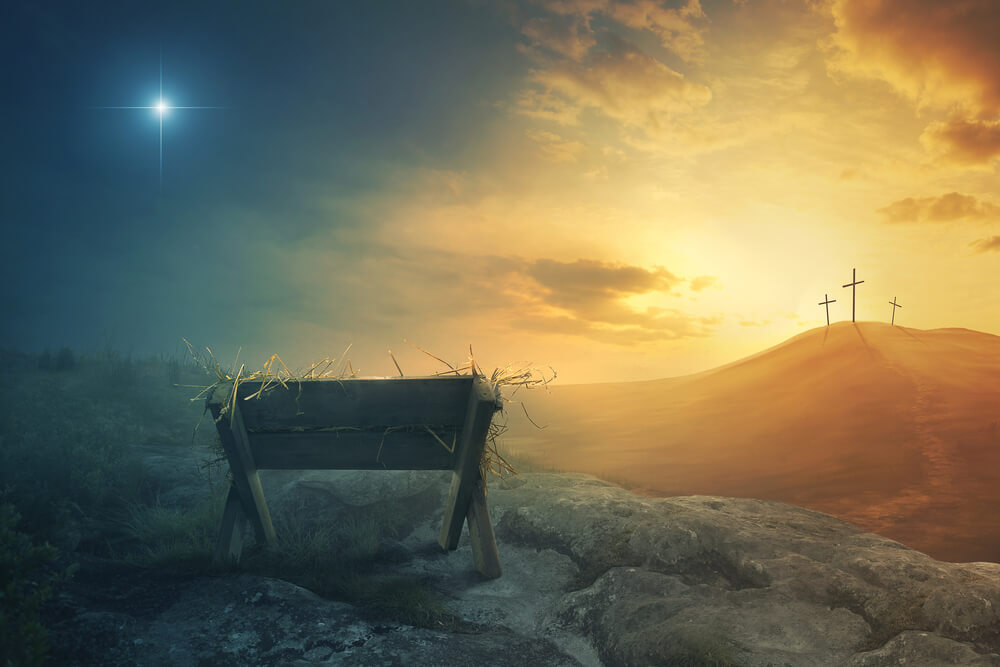During Advent and Christmas we hear Jesus referred to as Emmanuel, which means ‘God with us.’ And when we start to think about the Incarnation it can both fill us with awe and have us scratching our heads at the same time. How could Jesus be fully God and fully man? While it is a mystery, so we will never fully understand this side of heaven, our goal as Catholics should be to know Christ, and that includes knowing about His human and divine nature. But where do we even begin? It can often seem that learning about the Incarnation requires a degree in philosophy. How can regular Catholics better understand it?
Fr. Robert Spitzer, SJ, president of The Magis Center, recently stopped by The Drew Mariani Show™ to discuss the mystery of the Incarnation, and give a few analogies to help us better wrap our minds around it.
Fr. Spitzer said the first place to start is where all things began – with the Trinity. “If we’re going to understand the Incarnation we’re going to have to first get the Trinity down, in relation to the one infinite nature of God. There is one infinite nature, one infinite power in God.”
So all you have to do is get the Trinity down. No problem, right? Well, don’t worry. Fr. Spitzer gave a crash course in the Church’s teaching on the nature of the Trinity.
“Here’s a major, sort of easy approach to getting it,” he said. “The first thing to remember is that there is only one infinite nature in God. Sometimes that one, infinite nature is called the Godhead. But just think of it this way: it’s like the power source. When you talk about nature it is the power source – that from which it is and has its power. So there is one infinite power, one infinite act, one infinite nature in God.”
“There are not three Gods,” he clarified. “There are three self-consciousnesses making use of the one infinite power, the one infinite act, the one infinite nature of God.”
If you’re still scratching your head, Fr. Spitzer offered a modern-day version of St. Patrick’s shamrock analogy. “I’m going to make a crude analogy, but it’s like your CPU – your computer that has a central processing unit – and you’ve got three screens, three monitors, making use of that one power source. But this is an infinite power source.”
The reason it is so important to understand the Trinity is because it helps explain why Jesus could not have lost his divine nature when He became man. Fr. Spitzer emphasized, “The one thing as Catholics that we have to be so critical and careful to point out is that one, infinite nature can never become finite. So you can’t make an infinite thing finite. That’s a contradiction, that’s never going to work, and the Church never held that the infinite nature of God became finite.”
So now we come to the Incarnation, the arrival of Emmanuel. “Now, who becomes flesh?” Fr. Spitzer asked. “The second person of the Trinity. The second self-consciousness becomes human. That is to say, enters into flesh in this world, in this universe. Now remember, this universe is just a thought in the mind of God. So, it’s just one single thought in this huge expanse of this infinite mind, this infinite power source.”
So how can the Son enter into His own thought of Creation? Fr. Spitzer offered another analogy to help explain. He said, “We really only have one analogy for it, which has been used hundreds of times in Christianity, and that is dreaming.”
“When I dream of myself in dream-world, that’s a thought in my consciousness,” he explained. “So my dream-world is a thought in my consciousness, and sometimes my self-consciousness can even go into my own thought in my dream-world. So my self-consciousness is in my dream-world, and as self-consciousness I think I am in that world. In a sense, the real world in which I live is suspended and my self-consciousness is aware of my dream-world more than it is of the real world around me. And when that happens, there’s always that moment when I just wake up, and I think to myself that it’s a dream. And the minute I think it’s a dream, my self-consciousness is aware of my dream-world and the real world at the same time.”
“Now, is that what’s happening with God? No. But that’s the only analogy I have. But, by George, we do that. Our self-consciousness can enter into our dream world, enter into the real world, and enter into both simultaneously. So it just gives you an example of how that might be possible.”
Listen to the full conversation with Fr. Spitzer below:
The Drew Mariani Show airs weekdays from 3:00 – 6:00 p.m. Eastern/noon-3:00 p.m. Pacific on Relevant Radio® and the Relevant Radio App.


